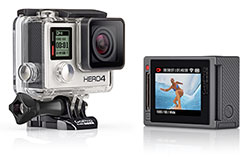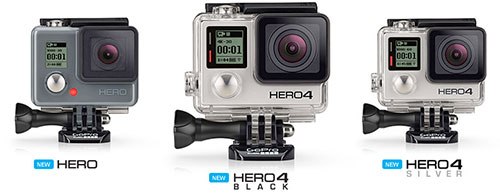« The unpredictable nature of screen sizes | Main | Intrinsically safe ecom Tab-Ex: another rugged tablet based on Samsung hardware »
September 29, 2014
GoPro 4 -- the GoPro phenomenon, how it came about, and why it matters
On September 29, 2014, GoPro announced the GoPro Hero 4 and also a new basic GoPro camera. This is relevant for anyone dealing with ruggedized computing gear and using technology in the field for a number of reasons. But first, what exactly is GoPro and why do their products matter?
 GoPro makes tiny little action cameras that, somehow, captured the public's imagination and are now found seemingly everywhere. You could almost say they've become a cultural phenomenon. GoPros are mounted on skydiver and motorcycle helmets, on race cars, on skateboards, on boats, on planes and drones, and seemingly on everything else, sometimes several of them. Now you can even mount them on dogs.
GoPro makes tiny little action cameras that, somehow, captured the public's imagination and are now found seemingly everywhere. You could almost say they've become a cultural phenomenon. GoPros are mounted on skydiver and motorcycle helmets, on race cars, on skateboards, on boats, on planes and drones, and seemingly on everything else, sometimes several of them. Now you can even mount them on dogs.
Why did this happen? GoPro cameras aren't particularly attractive — just featureless little boxes — and for several years they weren't very well known either. Initial markets were pretty much limited to what founder Nick Woodman had made the little camera for, surfers. Lore has it that since every surfer wants to be noticed and "go pro," that's where the name GoPro came from. Looks didn't matter as long as the camera could be mounted on a surfer or on a surf board, and as long as it could capture their exploits. Initial GoPros weren't particularly exceptional. Even by 2005, when increasingly capable digital cameras had long been available, the first GoPro was just a cheap Chinese-made plastic film camera. Digital video pioneered in the GoPro in 2006 in a little camera that looked remarkably what GoPros still look tray.
That, of course, was the era of the Flip camera with its USB port. Flip was wildly successful for a couple of years, but was then, for inexplicable reasons, bought by Cisco of all companies, which did not seem to have any interest in it and simply shut Flip down, apparently seeing no market for small inexpensive vidcams.
But two things were happening that made all the difference for fledgling GoPro. The first, of course, was the demise of Flip, which left lots of people wanting for a small handy action cam. The second was the technology convergence of immensely powerful new compression technology and inexpensive small storage media. Between those two technologies, it was suddenly possible to record glorious high definition video without the need for a big, bulky tape drive.
It's probably fair to say that without a company by the name of Ambarella, the GoPro revolution might never have taken place. That's because Ambarella provides the chips and intellectual property to process and compress high definition video so that hours of it can be recorded on inexpensive little SD and microSD storage cards.
So with a market pining for affordable, yet high-performance action cameras and Nick Woodman having the foresight to pack it all into his mighty little video cubes, the GoPro phenomenon was born. And that despite not even having been the first. RuggedPCReview editors reviewed the Liquid Image VideoMask and the Contour HD 1080p camcorder before, not being surfers, we even knew of the early GoPros.
Once we did get a hold of a GoPro Hero we published a detailed review entitled "GoPro Hero — the GoPro phenomenon: what the world-beating little 1080p vidcam can (and cannot) do" where we analyzed both the GoPro hardware and its performance in great detail. We were quite impressed with the "terrific HD video" and "stunning value" of the GoPro, but took major issue with GoPro's underwater housing that GoPro claimed was good to depths of 180 feet. The housing probably was, but its curved dome lens kept the camera from focusing underwater. Baffled we wrote in caps "YOU CANNOT USE THE CAMERA UNDERWATER BECAUSE IT WON'T FOCUS?!!?" Baffled was too mild a word, as we had used GoPros to record majestic giant Mantas hundreds of miles off the coast of Mexico in a once-in-a-lifetime trip, and the GoPro video was all blurry.
We reported in even greater detail on the GoPro Hero2, which still couldn't focus underwater. Apparently, the GoPro people were great surfers, but definitely not divers. The GoPro documentation now said "Please note that due to the curved lens of the HD HERO2 (and the original HD HERO) waterproof housing you will notice a slight loss of sharpness with underwater images." To which we responded in our report: "That is not good enough. It is NOT a slight loss. It makes the camera unusable underwater."
Our reviews, using third-party underwater housings that DID allow sharp focus, attracted GoPro's attention and we subsequently helped them with testing an underwater housing that worked and also underwater filters that addressed the early GoPros inability to adjust white balance to underwater conditions. Below is a brief video of the fun I had with a GoPro Hero2 and a pride of young sea lions off Coronado island in Mexico.
The GoPro Hero3 premiered October 2012 with an even better and less bulky underwater housing. The new line, whose body was even more compact than that of the Hero 1 and 2 and used tiny microSD cards, included a basic "White" model that performed at the Hero 1 level, a "Silver" Edition that was like an updated Hero2, and then there was the top-of-the-line "Black" Edition with a powerful Ambarella A7 chip that allowed recording 1080p video at 60 frames per second and, for the first time ever pretty much anywhere, 4K video, albeit only at 15 frames per second. The "Black" Edition could also shoot stills and shoot video simultaneously, and it had selectable white balance settings. We tested these new cameras both above and underwater and also shot many hours of underwater 3D video with GoPro's ingenious system of linking two cameras together.
About a year later came the Hero3+, a slightly smaller, fine-tuned version of the Hero3 that efficiently addressed a number of Hero3 omissions and shortcomings, such as better audio, close-ups, better low-light performance, etc.
And now, GoPro announced the Hero4, that includes the top-of-the-line Hero4 Black (US$499) and the Hero4 Silver (US$399), as well as a new basic camera, just called Hero (US$129). The most important features in the new models is that the Hero4 Black can do 4k video at a full 30 frames per second (and also 2.7k/50fps and 1080p/120). This means the camera is now capable of shooting usable 4k video and also high quality slow motion HD video. That could be a major boon to buyers of 4k HDTVs who find out that there really isn't any 4k content. The Hero4 Silver has roughly the same capabilities as the old Hero 3 Black but includes, a first for GoPros, an integrated LCD — prior GoPros could accommodate an optional snap-on LCD, but never came with an integrated one. The new US$129 entry-level Hero can do 1080p/30fps and 720p/60fps and is built directly into a waterproof housing.
What does that all mean? Overall, with the Hero4 GoPro addresses the criticism that its Hero3/3+ could only do 4k video at a technology demonstration level, as 15 frames per second is essentially useless. The new "Black" can do real 4k video, and the high res slow motion modes are very useful. The Hero4 will likely not only help GoPro to remain wildly successful, but also cement its reputation of being at the bleeding edge of technology. The new "Silver" camera takes roughly the place of the older 3/3+ Black, and with the new basic US$129 Hero, the company has an inexpensive, invulnerable and totally waterproof camera.

How does it all work? We don't know yet. We've had ample experience with numerous Hero 1, 2 and 3 models, but haven't been able to get any response from GoPro as of late. GoPro is now a public company whose stock premiered at US$24 a share on June 25, and has reached US$90 a share just three months later the morning of the Hero4 release.
What has made GoPro such a success? Like all phenomena it's a number of things that all came together at the right time. GoPros aren't pretty and they are difficult to use and their battery life is marginal, but they get the job done and then some. No one else thought of offering all the numerous (and inexpensive) mounting hardware that allows GoPros to go along for the ride virtually anywhere. No one else pushed recording of extreme sports as much as GoPro, and all using their signature ultra-wide angle. No other camera fueled the imagination of more videographers that used GoPros everywhere to show new angles and record what could not be recorded before. No one saw the potential of Ambarella's ground-breaking compression technology and inexpensive tiny storage cards as clearly as GoPro. And so here we are.
What does it mean for users of rugged computing gear? It means that stunningly powerful high-speed, high-definition recording capabilities are available inexpensively and in a form uniquely suited for field operations. In their cases that come standard with every GoPro, the little cameras are virtually indestructible and they can be used and mounted anywhere. Their recording performance is far above that of any camera integrated into any rugged handheld or tablet, and also above that of virtually all smartphones (and without the fear of breaking an expensive smartphone).
I think it's fair to say that virtually any job out there that benefits from using a rugged notebook, tablet or handheld would also benefit from bringing along a GoPro, or a few of them.
See GoPro's Hero4 press release
Posted by conradb212 at September 29, 2014 6:14 PM

















